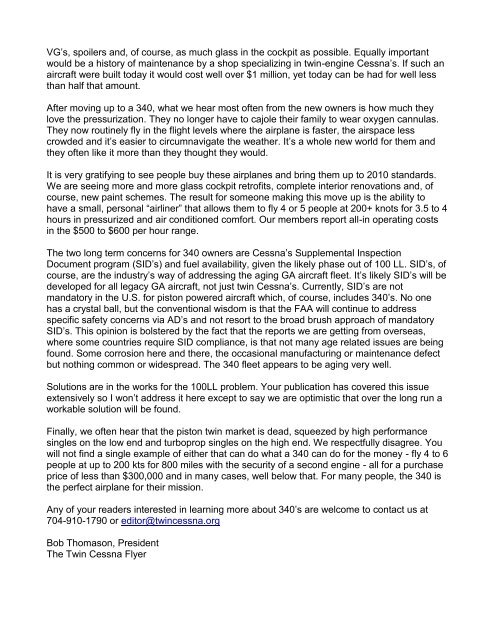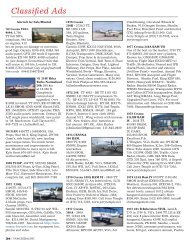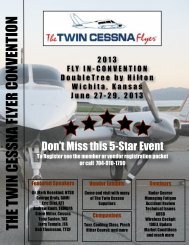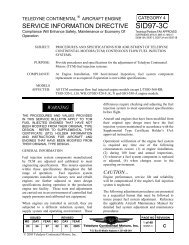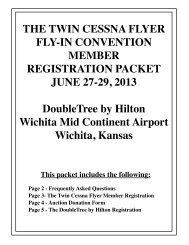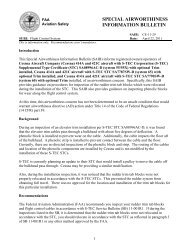340 Information - Twin Cessna Flyer
340 Information - Twin Cessna Flyer
340 Information - Twin Cessna Flyer
Create successful ePaper yourself
Turn your PDF publications into a flip-book with our unique Google optimized e-Paper software.
VG’s, spoilers and, of course, as much glass in the cockpit as possible. Equally important<br />
would be a history of maintenance by a shop specializing in twin-engine <strong>Cessna</strong>’s. If such an<br />
aircraft were built today it would cost well over $1 million, yet today can be had for well less<br />
than half that amount.<br />
After moving up to a <strong>340</strong>, what we hear most often from the new owners is how much they<br />
love the pressurization. They no longer have to cajole their family to wear oxygen cannulas.<br />
They now routinely fly in the flight levels where the airplane is faster, the airspace less<br />
crowded and it’s easier to circumnavigate the weather. It’s a whole new world for them and<br />
they often like it more than they thought they would.<br />
It is very gratifying to see people buy these airplanes and bring them up to 2010 standards.<br />
We are seeing more and more glass cockpit retrofits, complete interior renovations and, of<br />
course, new paint schemes. The result for someone making this move up is the ability to<br />
have a small, personal “airliner” that allows them to fly 4 or 5 people at 200+ knots for 3.5 to 4<br />
hours in pressurized and air conditioned comfort. Our members report all-in operating costs<br />
in the $500 to $600 per hour range.<br />
The two long term concerns for <strong>340</strong> owners are <strong>Cessna</strong>’s Supplemental Inspection<br />
Document program (SID’s) and fuel availability, given the likely phase out of 100 LL. SID’s, of<br />
course, are the industry’s way of addressing the aging GA aircraft fleet. It’s likely SID’s will be<br />
developed for all legacy GA aircraft, not just twin <strong>Cessna</strong>’s. Currently, SID’s are not<br />
mandatory in the U.S. for piston powered aircraft which, of course, includes <strong>340</strong>’s. No one<br />
has a crystal ball, but the conventional wisdom is that the FAA will continue to address<br />
specific safety concerns via AD’s and not resort to the broad brush approach of mandatory<br />
SID’s. This opinion is bolstered by the fact that the reports we are getting from overseas,<br />
where some countries require SID compliance, is that not many age related issues are being<br />
found. Some corrosion here and there, the occasional manufacturing or maintenance defect<br />
but nothing common or widespread. The <strong>340</strong> fleet appears to be aging very well.<br />
Solutions are in the works for the 100LL problem. Your publication has covered this issue<br />
extensively so I won’t address it here except to say we are optimistic that over the long run a<br />
workable solution will be found.<br />
Finally, we often hear that the piston twin market is dead, squeezed by high performance<br />
singles on the low end and turboprop singles on the high end. We respectfully disagree. You<br />
will not find a single example of either that can do what a <strong>340</strong> can do for the money - fly 4 to 6<br />
people at up to 200 kts for 800 miles with the security of a second engine - all for a purchase<br />
price of less than $300,000 and in many cases, well below that. For many people, the <strong>340</strong> is<br />
the perfect airplane for their mission.<br />
Any of your readers interested in learning more about <strong>340</strong>’s are welcome to contact us at<br />
704-910-1790 or editor@twincessna.org<br />
Bob Thomason, President<br />
The <strong>Twin</strong> <strong>Cessna</strong> <strong>Flyer</strong>


